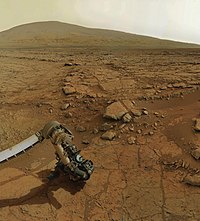
 |
| This article is one of a series on: |
| Life in the universe |
|---|
| Outline |
| Planetary habitability in the Solar System |
| Life outside the Solar System |
| Habitability of... |
The habitability of natural satellites is the potential of moons to provide habitats for life, though it is not an indicator that they harbor it. Natural satellites are expected to outnumber planets by a large margin and the study of their habitability is therefore important to astrobiology and the search for extraterrestrial life. There are, nevertheless, significant environmental variables specific to moons.
It is projected that parameters for surface habitats will be comparable to those of planets like Earth, namely stellar properties, orbit, planetary mass, atmosphere and geology. Of the natural satellites in the Solar System's habitable zone – the Moon, two Martian satellites (though some estimates put those outside it)[1] and numerous minor-planet moons – all lack the conditions for surface water. Unlike the Earth, all planetary mass moons of the Solar System are tidally locked and it is not yet known to what extent this and tidal forces influence habitability.
Research suggests that deep biospheres like that of Earth are possible.[2] The strongest candidates therefore are currently icy satellites[3] such as those of Jupiter and Saturn—Europa[4] and Enceladus[5] respectively, in which subsurface liquid water is thought to exist. While the lunar surface is hostile to life as we know it, a deep lunar biosphere (or that of similar bodies) cannot yet be ruled out;[6][7] deep exploration would be required for confirmation.
Exomoons are not yet confirmed to exist and their detection may be limited to transit-timing variation, which is not currently sufficiently sensitive.[8] It is possible that some of their attributes could be found through study of their transits.[9] Despite this, some scientists estimate that there are as many habitable exomoons as habitable exoplanets.[10][11] Given the general planet-to-satellite(s) mass ratio of 10,000, gas giants in the habitable zone are thought to be the best candidates to harbour Earth-like moons.[12]
Tidal forces are likely to play as significant a role providing heat as stellar radiation.[13][14]
- ^ "Phoenix Mars Mission – Habitability and Biology". University of Arizona. 2014-04-24. Archived from the original on 2014-04-16.
- ^ Boyd, Robert S. (8 March 2010). "Buried alive: Half of Earth's life may lie below land, sea". McClatchy DC. Archived from the original on 2014-04-25.
- ^ Castillo, Julie; Vance, Steve (2008). "Session 13. The Deep Cold Biosphere? Interior Processes of Icy Satellites and Dwarf Planets". Astrobiology. 8 (2): 344–346. Bibcode:2008AsBio...8..344C. doi:10.1089/ast.2008.1237. ISSN 1531-1074.
- ^ Greenberg, Richard (2011). "Exploration and Protection of Europa's Biosphere: Implications of Permeable Ice". Astrobiology. 11 (2): 183–191. Bibcode:2011AsBio..11..183G. doi:10.1089/ast.2011.0608. ISSN 1531-1074. PMID 21417946.
- ^ Parkinson, Christopher D.; Liang, Mao-Chang; Yung, Yuk L.; Kirschivnk, Joseph L. (2008). "Habitability of Enceladus: Planetary Conditions for Life". Origins of Life and Evolution of Biospheres. 38 (4): 355–369. Bibcode:2008OLEB...38..355P. doi:10.1007/s11084-008-9135-4. ISSN 0169-6149. PMID 18566911. S2CID 15416810.
- ^ Lingam, Manasvi; Loeb, Abraham (2020-09-21). "Potential for Liquid Water Biochemistry Deep under the Surfaces of the Moon, Mars, and beyond". The Astrophysical Journal. 901 (1). American Astronomical Society: L11. arXiv:2008.08709. Bibcode:2020ApJ...901L..11L. doi:10.3847/2041-8213/abb608. ISSN 2041-8213.
- ^ Crawford, Ian A; Cockell, Charles S (2010-07-23). "Astrobiology on the Moon". Astronomy & Geophysics. 51 (4). Oxford University Press (OUP): 4.11–4.14. Bibcode:2010A&G....51d..11C. doi:10.1111/j.1468-4004.2010.51411.x. ISSN 1366-8781.
- ^ Kipping, David M.; Fossey, Stephen J.; Campanella, Giammarco (2009). "On the detectability of habitable exomoons withKepler-class photometry". Monthly Notices of the Royal Astronomical Society. 400 (1): 398–405. arXiv:0907.3909. Bibcode:2009MNRAS.400..398K. doi:10.1111/j.1365-2966.2009.15472.x. ISSN 0035-8711. S2CID 16106255.
- ^ Kaltenegger, L. (2010). "Characterizing Habitable Exomoons". The Astrophysical Journal. 712 (2): L125–L130. arXiv:0912.3484. Bibcode:2010ApJ...712L.125K. doi:10.1088/2041-8205/712/2/L125. ISSN 2041-8205. S2CID 117385339.
- ^ Shriber, Michael (26 Oct 2009). "Detecting Life-Friendly Moons". Astrobiology Magazine. Archived from the original on 2021-03-09. Retrieved 9 May 2013.
{{cite web}}: CS1 maint: unfit URL (link) - ^ "Exomoons Could Be As Likely To Host Life As Exoplanets, Claims Scientists". Cosmos Up. 21 May 2018. Archived from the original on 28 May 2018. Retrieved 27 May 2018.
- ^ Jorgenson, Amber (5 June 2018). "Kepler data reveals 121 gas giants that could harbor habitable moons". Astronomy. Archived from the original on 3 January 2023. Retrieved 9 June 2018.
- ^ Cowen, Ron (2008-06-07). "A Shifty Moon". Science News. Archived from the original on 2011-11-04. Retrieved 2013-05-12.
- ^ Bryner, Jeanna (24 June 2009). "Ocean Hidden Inside Saturn's Moon". Space.com. TechMediaNetwork. Archived from the original on 16 September 2009. Retrieved 22 April 2013.